Lead Compounds from Mangrove-Associated Microorganisms
- PMID: 30205507
- PMCID: PMC6165052
- DOI: 10.3390/md16090319
Lead Compounds from Mangrove-Associated Microorganisms
Abstract
The mangrove ecosystem is considered as an attractive biodiversity hotspot that is intensively studied in the hope of discovering new useful chemical scaffolds, including those with potential medicinal application. In the past two decades, mangrove-derived microorganisms, along with mangrove plants, proved to be rich sources of bioactive secondary metabolites as exemplified by the constant rise in the number of publications, which suggests the great potential of this important ecological niche. The present review summarizes selected examples of bioactive compounds either from mangrove endophytes or from soil-derived mangrove fungi and bacteria, covering the literature from 2014 to March 2018. Accordingly, 163 natural products are described in this review, possessing a wide range of potent bioactivities, such as cytotoxic, antibacterial, antifungal, α-glucosidase inhibitory, protein tyrosine phosphatase B inhibitory, and antiviral activities, among others.
Keywords: bioactive natural products; drug leads; endophytes; mangrove microorganisms.
Conflict of interest statement
The authors declare no conflict of interest.
Figures





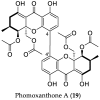

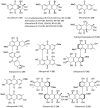

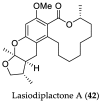


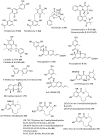
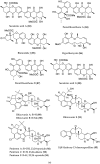

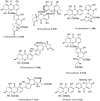








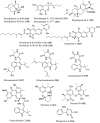
Similar articles
-
[Microbial secondary metabolites as potential reserve of pharmaceuticals].Antibiot Khimioter. 2014;59(3-4):38-44. Antibiot Khimioter. 2014. PMID: 25300120 Review. Russian.
-
Bioactive natural products from endophytes: a review.Prikl Biokhim Mikrobiol. 2008 Mar-Apr;44(2):153-8. Prikl Biokhim Mikrobiol. 2008. PMID: 18669256 Review.
-
Bioprospecting of endophytic microorganisms for bioactive compounds of therapeutic importance.Arch Microbiol. 2021 Jul;203(5):1917-1942. doi: 10.1007/s00203-021-02256-z. Epub 2021 Mar 7. Arch Microbiol. 2021. PMID: 33677637 Review.
-
Two new secondary metabolites from the mangrove endophytic fungus Pleosporales sp. SK7.Nat Prod Res. 2020 Oct;34(20):2919-2925. doi: 10.1080/14786419.2019.1598993. Epub 2019 Apr 10. Nat Prod Res. 2020. PMID: 30966793
-
Secondary Metabolites of Mangrove-Associated Strains of Talaromyces.Mar Drugs. 2018 Jan 6;16(1):12. doi: 10.3390/md16010012. Mar Drugs. 2018. PMID: 29316607 Free PMC article. Review.
Cited by
-
α-Glucosidase Inhibitors from Two Mangrove-Derived Actinomycetes.Molecules. 2023 Apr 29;28(9):3822. doi: 10.3390/molecules28093822. Molecules. 2023. PMID: 37175232 Free PMC article.
-
Deciphering the Microbial Taxonomy and Functionality of Two Diverse Mangrove Ecosystems and Their Potential Abilities To Produce Bioactive Compounds.mSystems. 2020 Oct 27;5(5):e00851-19. doi: 10.1128/mSystems.00851-19. mSystems. 2020. PMID: 33109752 Free PMC article.
-
Dechlorination of wastewater from shell-based glucosamine processing by mangrove wetland-derived fungi.Front Microbiol. 2023 Oct 13;14:1271286. doi: 10.3389/fmicb.2023.1271286. eCollection 2023. Front Microbiol. 2023. PMID: 37901808 Free PMC article.
-
Biosynthesis of Novel Tellurium Nanorods by Gayadomonas sp. TNPM15 Isolated from Mangrove Sediments and Assessment of Their Impact on Spore Germination and Ultrastructure of Phytopathogenic Fungi.Microorganisms. 2023 Feb 22;11(3):558. doi: 10.3390/microorganisms11030558. Microorganisms. 2023. PMID: 36985132 Free PMC article.
-
Diversity and structure of the root-associated bacterial microbiomes of four mangrove tree species, revealed by high-throughput sequencing.PeerJ. 2023 Oct 4;11:e16156. doi: 10.7717/peerj.16156. eCollection 2023. PeerJ. 2023. PMID: 37810771 Free PMC article.
References
-
- Tomlinson P.B. The Botany of Mangroves. 2nd ed. Cambridge University Press; Cambridge, UK: 2016. Ecology; pp. 11–28.
-
- Saenger P. Mangrove Ecology, Silviculture and Conservation. Springer; Dordrecht, The Netherlands: 2002. pp. 11–47.
-
- Wang L., Mu M., Li X., Lin P., Wang W. Differentiation between true mangroves and mangrove associates based on leaf traits and salt contents. J. Plant Ecol. 2011;4:292–301. doi: 10.1093/jpe/rtq008. - DOI
Publication types
MeSH terms
Substances
Grants and funding
LinkOut - more resources
Full Text Sources
Other Literature Sources
Medical
Miscellaneous

